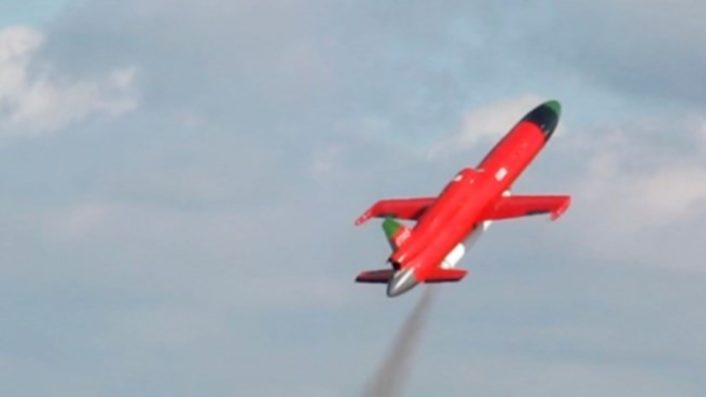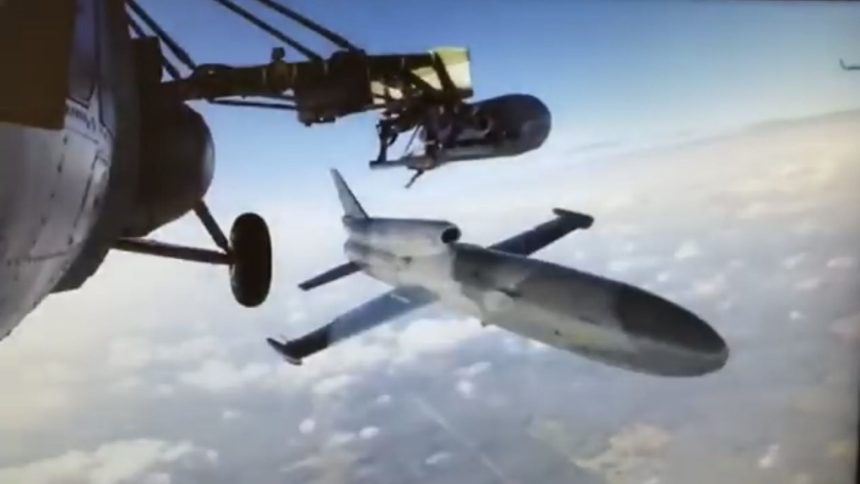The drone’s use is likely to provoke Ukrainian air defenses and present a dilemma between protecting targets in Odessa and preserving their surface-to-air missile stocks.
The escalating war in the Black Sea between Russia and Ukraine saw another innovation on the morning of May 29, 2025, when Ukraine’s General Intelligence Directorate (GUR) said it shot down a jet-powered Russian target drone it identified as the DAN-M. With a new warhead, and possibly tweaked guidance section, it was presumably being used as a cruise missile. The system was originally developed by the OKB Simonova, also called the Sokol Design Bureau.
The video of the night time engagement showed a missile fired from a ground-launcher, streaking into the sky, and infrared footage of an object falling into the water – indicating the target had been shot down. The missile being fired is likely a R-73 Archer missile repurposed as surface-to-air missile, as the video mentioned its use to intercept the drone.
According to leading Ukrainian handle ‘Serhey Flash’, the attack took place in the morning where either a single or a number of DAN-Ms were launched from Crimea, where the “reactive target for training and testing […] was converted into an impact UAV.” The drone’s use is very likely to be an experiment to see how Ukrainian air defenses respond, if they take the bait, and present a dilemma between protecting the drone and USV factories in Odessa and preserving their surface-to-air missile (SAM) stocks.
The DAN-M’s use comes after the loss of two Russian Su-30SMs on May 2 and May 3 over the Black Sea to AIM-9 air-to-air missiles, converted to be used in the SAM role and fired not by an aircraft, but a Magura V7 Unmanned Surface Vessel (USV).
💥New Russian “DAN-M” Jet Drone Shot Down Over Black Sea by Ukrainian Air Defense
On May 29, 2025, Ukrainian forces used a mobile air defense system developed by the Defense Intelligence of Ukraine (HUR) to shoot down a Russian jet-powered drone near Odesa.
The system, equipped… pic.twitter.com/ozhNANrsH6
— Special Kherson Cat 🐈🇺🇦 (@bayraktar_1love) May 30, 2025
Ukraine in February also received two British-developed “Gravehawk” systems, using Ukraine’s Soviet-era R-73 AAMs as containerized anti-air missile systems. As The Aviationist reported, fifteen more units are expected this year. According to ‘MilitaryNewsUA’, who reposted the GUR’s video, the DAN-M was intercepted by a “mobile anti-aircraft missile system, equipped with R-73 missiles developed by specialists of the Main Intelligence Directorate of the Ministry of Defense of Ukraine with the support of foreign partners,” although it is unclear if the Gravehawk was involved as Ukraine is now using multiple systems to employ the R-73 as SAM.
DAN-M target drone
The drone-turned-cruise missile looks a lot similar to the Soviet-era Strizh-141/143 high-speed reconnaissance drones that Ukraine previously converted into land-strike cruise missiles to hit Russian air bases in 2022.
The DAN-M’s propulsion section, from the intake to the main powerplant and exhaust, is fully dorsally-mounted, running from the middle of the weapon to the tail end. This design configuration is consistent with many older generation pilotless target drones.
Most cruise missiles otherwise only have the inlet jutting out, with the engine and the exhaust embedded inside the main body. Serhey said the missile can fly at altitudes of up to 9,000 meters at speeds between 450-700 km/hour with an endurance of 25 to 40 minutes.
Videos circulated by various users showed a collage of images of a Mi-8 helicopter carrying two DAN-Ms on its outboard pylons and firing both successively, where the drone/missiles ignite their motors after descending. Another external and in-flight footage of a ground-launched DAN-M is shown, where the drone is fired from a rail launcher propelled by a jettisonable booster that later falls off. Both the Mi-8 and the land-fired DAN-Ms then end their journey by descending with a parachute deployed parachute.
Today, the new 🇷🇺 Russian Dan-M jet drone, its technical characteristics and individual photos are often mentioned in the news.
I want to suggest a short video that might be of interest to someone. Join us. pic.twitter.com/dUJeG8LENK
— Capt(N) (@Capt_Navy) May 29, 2025
The videos are possibly from a previous Russian test. How the Russians launched the DAN-M in the latest incident is not known, and the launch has also not featured in the recent series of Russian MoD (RuMoD) battlefield updates.
Defense Express claimed that the Russians fielded an improved DAN-M in 2020, with a “partial update of the onboard electronics and a new small-sized MGTD-125E turbojet engine […] to replace the MD-120.” The report further added that the DAN-M “gives Russian forces a weapon to strike targets based on known coordinates at ranges 300 to 400 km.”
Russian goals
The choice of the system and its design allows for more guidance and navigation systems to be stored in the main body, where stealth is not a priority, while the goal is to draw anti-air fire. Ukraine President Volodymyr Zelenskyy has periodically complained when Western NATO air defense systems like the Patriot, NASAMS, SAMP/T were running out to Russia’s Geran-2 kamikaze drone, Iskander tactical ballistic missile and Kh-101 ALCM.

The latest such grievance was reported by Le Monde on May 26, 2025, which said the “several Patriot divisions around Kyiv […] cannot provide 100% protection against ballistic missiles.” The phenomenon also shows how both Ukraine and Russia command that ‘asymmetric’ advantage in different theaters of the war, with Ukraine holding the overall edge in the Black Sea, and Russia in the lead over the ground.
Lastly, we do not know about the Russian DAN-M stocks, but they can be assumed to be substantial. Even a one-off trial will not be undertaken until it has a large inventory to scale up the modification, if required. Ukraine would not use its larger advanced air defense missiles like the Patriot, NASAMS, Hawk or the SAMP/T to intercept a target like the DAN-M. It has therefore repurposed the target drone precisely for smaller missiles like the R-73 or the AIM-9.
Senjata Iran Pemintas Drone Karrar 3 Berpandu Infra Red ( udara ke udara ) yang Mampu Terbang diatas 47.000 kaki 👉kini telah di siagakan dan dihadapkan ke udara siap meluncur kapanpun diperintahkan pic.twitter.com/Q60hWilO2a
— 𝙾𝙼𝙹 𝑻 𝑳𝒖𝒄𝒌𝒚² (@OmJ_JeNggot) October 23, 2023
Defense Express however raised a curious question about the choice of the DAN-M since “nothing about this drone is mass-produced,” and that its “too low” stocks are not worth the investment. This gives rise to the possibility that the Ukrainians might have also misidentified the missile in the first place. It would be worth noting that the system bears a striking similarity to the Iranian Karrar interceptor drone, which is also able to fire air-to-air missiles.









